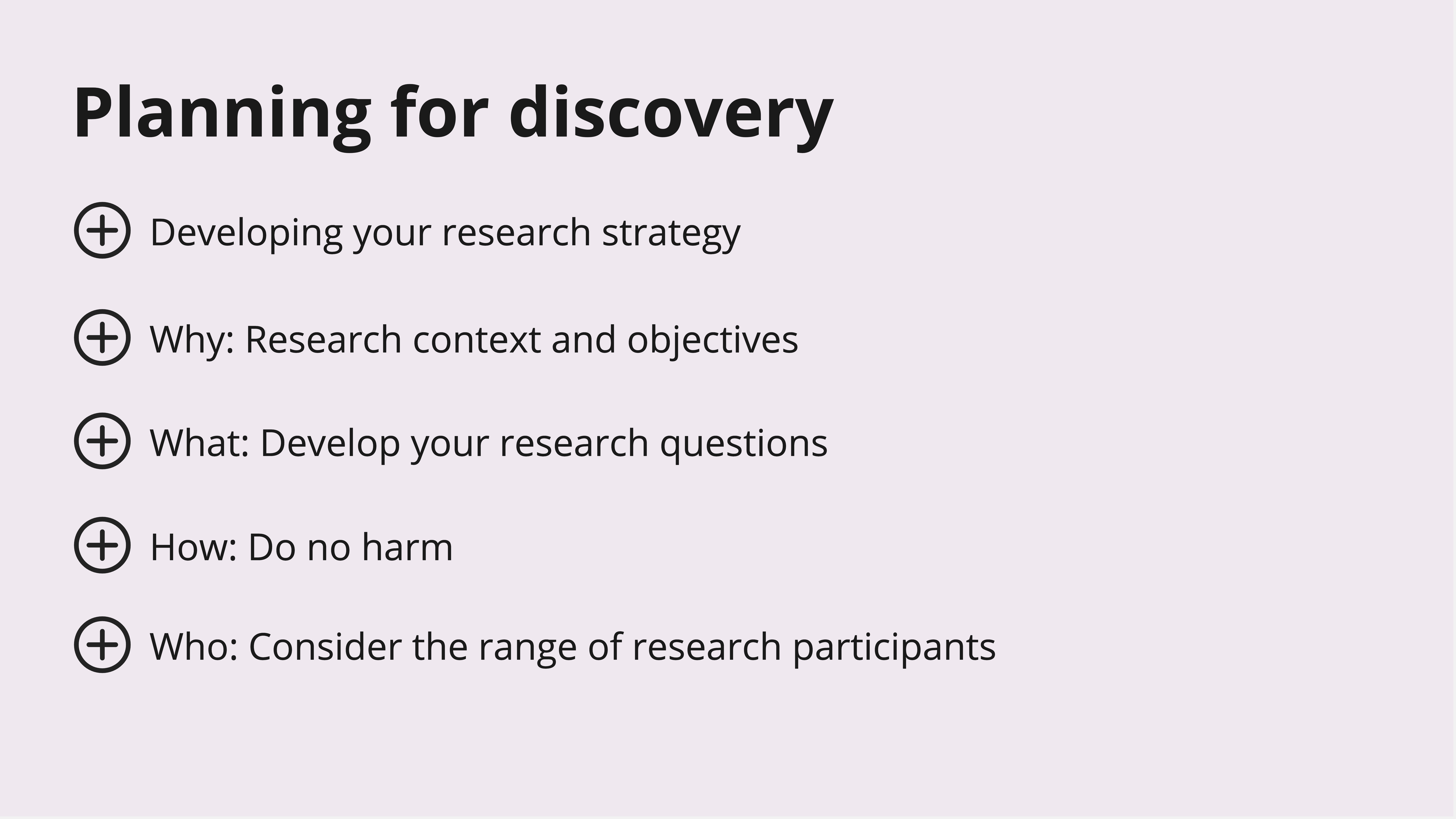Getting Started: Decide your Discovery objectives and approach - what problem(s) will you want to explore?
Tip: Remember, Discovery is an exploratory phase. Your approach at this point should be more oriented towards open questions and exploring the problem from different perspectives. This can and should involve defining what the problem is.

Developing your user research strategy
How we do user research depends on the goal. Are you:
- Seeking to understand potential users and their lives?
- Working out what the team should be designing?
- Testing things the team have designed to find and understand any issues?
You will continue to develop your user research approach throughout the project. In Discovery research questions may start broad and evolve quickly as you learn. They should become more specific in later development phases.
Ask yourself:
- Why is this user research worth doing?
- What is the purpose of my user research? What am I trying to find out?
- How will the proposed user research answer the questions asked?
- Who will we need to do user research with?
Why: User research context and objectives
- Describe the knowledge gap you will address. Why do this now? Why is it important?
- Consider what you already know, or whether anyone else has done something similar or related.
- Decide what you will not be looking at, and why
What: Develop your user research questions
- Consider what you need to know – asking when, where, who, how, why will help.
- Your questions should be clear and researchable.
How: Do no harm
How will you ensure your own and your participants’ wellbeing and psychological safety? How will you balance possible benefits of your user research against burns and risk of harm?
Who: Consider the range of user research participants
Who will you need to do user research with? Depending on what you need to learn this could be all the different users of your service, or just specific groups. It may also involve those who don't use the service. Be sure to include those who deliver the service or other stakeholders.
Ask yourself:
Who do you need to speak with to learn more about the problem?
- How shall we engage with them, when, where?
- Do you anticipate any barriers to access? How will you address them?
- Who do we need to involve? (Use your stakeholder maps; if you don't have them, start developing them now)
Hints and tips
- We need to understand the culture and goals of the system/organisation providing the service and the people working in the system – don't forget to plan for this.
- Visualise your findings to help yourself and others to see the insights. This will be important to enable sense-making of the data and to support us to make change happen.
- It is helpful to have a range of different types of information to inform your work. Quantitative (numerical) data (ie statistics, population data, usage analytics) can provide a sense of 'what' or 'how many', while qualitative (narrative) data (ie feedback, interviews, user focus groups) can help to explore user motivation and experience. Neither is inherently better than the other; they serve different purposes.
- Co-design is an approach to designing with, not for people. It involves sharing power, prioritising relationships, working in partnership and building capability. How are you bringing a co-design mindset to your research?
- It's important to consider ethics throughout the project. Service design projects are iterative. This can be a challenge if you are faced with traditional ethical approval processes which expect that you have every aspect of your research planned in advance. You will need to continually update your approach, plans and potentially your documentation.
Resources to support research planning
|
Resource |
Source |
What is it and what is it for? |
|---|---|---|
|
Service Design Tools |
Research planning template developed specifically for service design research | |
|
UK Government |
Guide to user research in service design with detailed recommendations for planning and case studies |
|
|
Beyond Sticky Notes |
Reflect on your mindsets (ways of thinking and being) that you bring to the research and design work |
|
|
Pollock, Meagan (2021 March 24). What is positionality?. Engineer Inclusion |
Explore your positionality, the social and political context that creates your identity, and how your identity influences and biases your perception of and outlook on the world. |
|
|
Introducing the cross-government user research ethics network |
UK Government |
Blog from the UK Cross-Government User Research Ethics Network, with links to resources from the community |
|
UXR |
Range of resources on ethical issues in user research, from short overviews to deep dives. |
|
|
NHS Education for Scotland |
Learn about the impact of trauma and how to develop a trauma-informed approach |
|
|
US Department of Justice, Office for the Victims of Crime |
Wealth of resources on supporting those at risk of vicarious trauma which can support trauma-informed research. |
|
|
Information Commissioner’s Office |
Detailed guide to data protection, including links to data protection impact |
